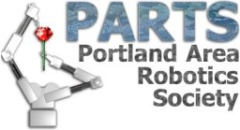The BrushBotComm boards and parts have arrived and the first couple boards are blinking their LEDs!

 One is shown with the battery holder board; the other has a connector for external power.
One is shown with the battery holder board; the other has a connector for external power.
Yesterday I got together with Scott and Jim, the guys behind the “Extreme Surface Mount Soldering” Instructable, and we soldered a couple boards up using their IR-thermometer enabled PID-controlled hot-plates. This was a test run in preparation for the group build that will be happening soon, but not next Monday as originally planned (more on that in a bit).
We had most of the parts for yesterday’s hot plate soldering, but I didn’t get the Mouser parts until this evening’s DorkBot meeting. So, I came prepared with soldering iron and tweezers to add the MOSFET’s, IR receiver and battery holders right there in Backspace. Unfortunately there’s still one missing component — the catch diodes for the MOSFETS. Looks like I left them out of the order… doh!
The boards powered up and programmed using ISP and Atmel’s AvrStudio with no problems. The hot-plate reflow worked great and no rework was required. I’m excited for everybody else to try the hot-plate method of soldering — it really opens up what you can do with surface mount on your own.
Originally the plan was to assemble all the boards at this coming Monday’s project meeting, but the logistics aren’t going to work out. The bRainSilo is undergoing some work to fix it up, so I’m not sure what state it’s going to be in next Monday, and as it is now, I’m not sure there is enough usable table space to do the assembly. There’s also a bunch of parts preparation that’s not going to happen by then. So, I’m thinking either the following project meeting, or maybe even as part of March’s general meeting. The latter would be nice because there’s more table space, but I’m not sure what Pete has planned for that meeting (Pete?), and the different time (Saturday morning versus Monday evening) might not work for all… What do you all think?
Meanwhile, consider coding up some routines for the tiny44 to have ready to try out:
IR remote control receiver code (i.e. light up an LED when a remote control code is received)
IR transmitter code (i.e. modulate the IR LED at 38kHz and encode a command to turn off a TV)
IR message-passing code
Monty


